A Flexible 360-Degree Thermal Sound Source Based on Laser Induced Graphene
Abstract
:1. Introduction
2. Experimental Procedure
2.1. Materials Preparation
2.2. Fabrication of the 360-Degree Thermal Sound Source
2.3. Performance Testing of the 360-Degree Thermal Sound Source
3. Results and Discussions
4. Conclusions
Acknowledgments
Author Contributions
Conflicts of Interest
References
- Sekitani, T.; Yokota, T.; Zschieschang, U.; Klauk, H.; Bauer, S.; Takeuchi, K.; Takamiya, M.; Sakurai, T.; Someya, T. Transistors for Flexible Sensor Arrays. Science 2009, 326, 1516–1519. [Google Scholar] [CrossRef] [PubMed]
- Yamada, T.; Hayamizu, Y.; Yamamoto, Y.; Yomogida, Y.; Izadi-Najafabadi, A.; Futaba, D.N.; Hata, K. A stretchable carbon nanotube strain sensor for human-motion detection. Nat. Nanotechnol. 2011, 6, 296–301. [Google Scholar] [CrossRef] [PubMed]
- Wang, Y.; Yang, R.; Shi, Z.; Zhang, L.; Shi, D.; Wang, E.; Zhang, G. Super-elastic graphene ripples for flexible strain sensors. ACS Nano 2011, 5, 3645–3650. [Google Scholar] [CrossRef] [PubMed]
- Gullapalli, H.; Vemuru, V.S.M.; Kumar, A.; Botello-Mendez, A.; Vajtai, R.; Terrones, M.; Nagarajaiah, S.; Ajayan, P.M. Flexible piezoelectric ZnO-paper nanocomposite strain sensor. Small 2010, 6, 1641–1646. [Google Scholar] [CrossRef] [PubMed]
- Schindler, A.; Brill, J.; Fruehauf, N.; Novak, J.P.; Yaniv, Z. Solution-deposited carbon nanotube layers for flexible display applications. Phys. E Low-Dimens. Syst. Nanostruct. 2007, 37, 119–123. [Google Scholar] [CrossRef]
- Kim, S.; Kwon, H.J.; Lee, S.; Shim, H.; Chun, Y.; Choi, W.; Kwack, J.; Han, D.; Song, M.; Mohammadi, S.; et al. Low-Power Flexible Organic Light-Emitting Diode Display Device. Adv. Mater. 2011, 23. [Google Scholar] [CrossRef] [PubMed]
- Yagi, I.; Hirai, N.; Miyamoto, Y.; Noda, M.; Imaoka, A.; Yoneya, N.; Nomoto, K.; Kasahara, J.; Yumoto, A.; Urabe, T. A flexible full-color AMOLED display driven by OTFTs. J. Soc. Inf. Disp. 2008, 16, 15–20. [Google Scholar] [CrossRef]
- Wang, J.; Liang, M.; Fang, Y.; Qiu, T.; Zhang, J.; Zhi, L. Rod-coating: Towards large-area fabrication of uniform reduced graphene oxide films for flexible touch screens. Adv. Mater. 2012, 24, 2874–2878. [Google Scholar] [CrossRef] [PubMed]
- Gwon, H.; Kim, H.-S.; Lee, K.U.; Seo, D.-H.; Park, Y.C.; Lee, Y.-S.; Ahn, B.T.; Kang, K. Flexible energy storage devices based on graphene paper. Energy Environ. Sci. 2011, 4, 1277–1283. [Google Scholar] [CrossRef]
- Wang, X.; Lu, X.; Liu, B.; Chen, D.; Tong, Y.; Shen, G. Flexible energy-storage devices: Design consideration and recent progress. Adv. Mater. 2014, 26, 4763–4782. [Google Scholar] [CrossRef] [PubMed]
- Jost, K.; Perez, C.R.; McDonough, J.K.; Presser, V.; Heon, M.; Dion, G.; Gogotsi, Y. Carbon coated textiles for flexible energy storage. Energy Environ. Sci. 2011, 4, 5060–5067. [Google Scholar] [CrossRef]
- Arnold, H.D.; Crandall, I.B. The thermophone as a precision source of sound. Phys. Rev. 1917, 10. [Google Scholar] [CrossRef]
- Tao, L.-Q.; Liu, Y.; Tian, H.; Ju, Z.-Y.; Xie, Q.-Y.; Yang, Y.; Ren, T.-L. A novel thermal acoustic device based on porous graphene. AIP Adv. 2016, 6. [Google Scholar] [CrossRef]
- Tian, H.; Li, C.; Mohammad, M.A.; Cui, Y.L.; Mi, W.T.; Yang, Y.; Xie, D.; Ren, T.L. Graphene earphones: Entertainment for both humans and animals. ACS Nano 2014, 8, 5883–5890. [Google Scholar] [CrossRef] [PubMed]
- Tian, H.; Xie, D.; Yang, Y.; Ren, T.L.; Lin, Y.X.; Chen, Y.; Wang, Y.F.; Zhou, C.J.; Peng, P.G.; Wang, L.G.; et al. Flexible, ultrathin, and transparent sound-emitting devices using silver nanowires film. Appl. Phys. Lett. 2011, 99. [Google Scholar] [CrossRef]
- Tian, H.; Xie, D.; Yang, Y.; Ren, T.-L.; Wang, Y.-F.; Zhou, C.-J.; Peng, P.-G.; Wang, L.-G.; Liu, L.-T. Transparent, flexible, ultrathin sound source devices using Indium Tin oxide films. Appl. Phys. Lett. 2011, 99. [Google Scholar] [CrossRef]
- Tian, H.; Yang, Y.; Xie, D.; Ge, J.; Ren, T.-L. A reduced graphene oxide sound-emitting device: A new use for Joule heating. RSC Adv. 2013, 3, 17672–17676. [Google Scholar] [CrossRef]
- Xie, Q.-Y.; Ju, Z.-Y.; Tian, H.; Xue, Q.-T.; Chen, Y.-Q.; Tao, L.-Q.; Mohammad, M.A.; Zhang, X.-Y.; Yang, Y.; Ren, T.-L. A point acoustic device based on aluminum nanowires. Nanoscale 2016, 8, 5516–5525. [Google Scholar] [CrossRef] [PubMed]
- Tao, L.; Jiang, S.; Li, C.; Tian, H.; Deng, N.; Wang, D.; Yang, Y.; Ren, T.-L. The use of graphene-based earphones in wireless communication. Tsinghua Sci. Technol. 2015, 20, 270–276. [Google Scholar]
- Tian, H.; Ren, T.-L.; Xie, D.; Wang, Y.-F.; Zhou, C.-J.; Feng, T.-T.; Yang, Y.; Peng, P.-G.; Wang, L.-G.; Liu, L.-T. Graphene-on-Paper Sound Source Devices. ACS Nano 2011, 5, 4878–4885. [Google Scholar] [CrossRef] [PubMed]
- Tian, H.; Xie, D.; Yang, Y.; Ren, T.-L.; Wang, Y.-F.; Zhou, C.-J.; Peng, P.-G.; Wang, L.-G.; Liu, L.-T. Single-layer graphene sound-emitting devices: Experiments and modeling. Nanoscale 2012, 4, 2272–2277. [Google Scholar] [CrossRef] [PubMed]
- Tian, H.; Yang, Y.; Li, C.; Mi, W.-T.; Mohammad, M.A.; Ren, T.-L. A flexible, transparent and ultrathin single-layer graphene earphone. RSC Adv. 2015, 5, 17366–17371. [Google Scholar] [CrossRef]
- El-Kady, M.F.; Kaner, R.B. Direct laser writing of graphene electronics. ACS Nano 2014, 8, 8725–8729. [Google Scholar] [CrossRef] [PubMed]
- Tian, H.; Yang, Y.; Xie, D.; Cui, Y.-L.; Mi, W.-T.; Zhang, Y.; Ren, T.-L. Wafer-scale integration of graphene-based electronic, optoelectronic and electroacoustic devices. Sci. Rep. 2014, 4. [Google Scholar] [CrossRef] [PubMed]
- Tian, H.; Chen, H.-Y.; Ren, T.-L.; Li, C.; Xue, Q.-T.; Mohammad, M.A.; Wu, C.; Yang, Y.; Wong, H.-S.P. Cost-Effective, Transfer-Free, Flexible Resistive Random Access Memory Using Laser-Scribed Reduced Graphene Oxide Patterning Technology. Nano Lett. 2014, 14, 3214–3219. [Google Scholar] [CrossRef] [PubMed]
- Lin, J.; Peng, Z.; Liu, Y.; Ruiz-Zepeda, F.; Ye, R.; Samuel, E.L.G.; Yacaman, M.J.; Yakobson, B.I.; Tour, J.M. Laser-induced porous graphene films from commercial polymers. Nat. Commun. 2014, 5. [Google Scholar] [CrossRef] [PubMed]
- El-Kady, M.F.; Strong, V.; Dubin, S.; Kaner, R.B. Laser scribing of high-performance and flexible graphene-based electrochemical capacitors. Science 2012, 335, 1326–1330. [Google Scholar] [CrossRef] [PubMed]
- El-Kady, M.F.; Kaner, R.B. Scalable fabrication of high-power graphene micro-supercapacitors for flexible and on-chip energy storage. Nat. Commun. 2013, 4. [Google Scholar] [CrossRef] [PubMed]
- Singh, R.S.; Nalla, V.; Chen, W.; Wee, A.T.S.; Ji, W. Laser patterning of epitaxial graphene for Schottky junction photodetectors. ACS Nano 2011, 5, 5969–5975. [Google Scholar] [CrossRef] [PubMed]
- Guo, L.; Jiang, H.-B.; Shao, R.-Q.; Zhang, Y.-L.; Xie, S.-Y.; Wang, J.-N.; Li, X.-B.; Jiang, F.; Chen, Q.-D.; Zhang, T. Two-beam-laser interference mediated reduction, patterning and nanostructuring of graphene oxide for the production of a flexible humidity sensing device. Carbon 2012, 50, 1667–1673. [Google Scholar] [CrossRef]
- Suk, J.W.; Kirk, K.; Hao, Y.; Hall, N.A.; Ruoff, R.S. Thermoacoustic sound generation from monolayer graphene for transparent and flexible sound sources. Adv. Mater. 2012, 24, 6342–6347. [Google Scholar] [CrossRef] [PubMed]
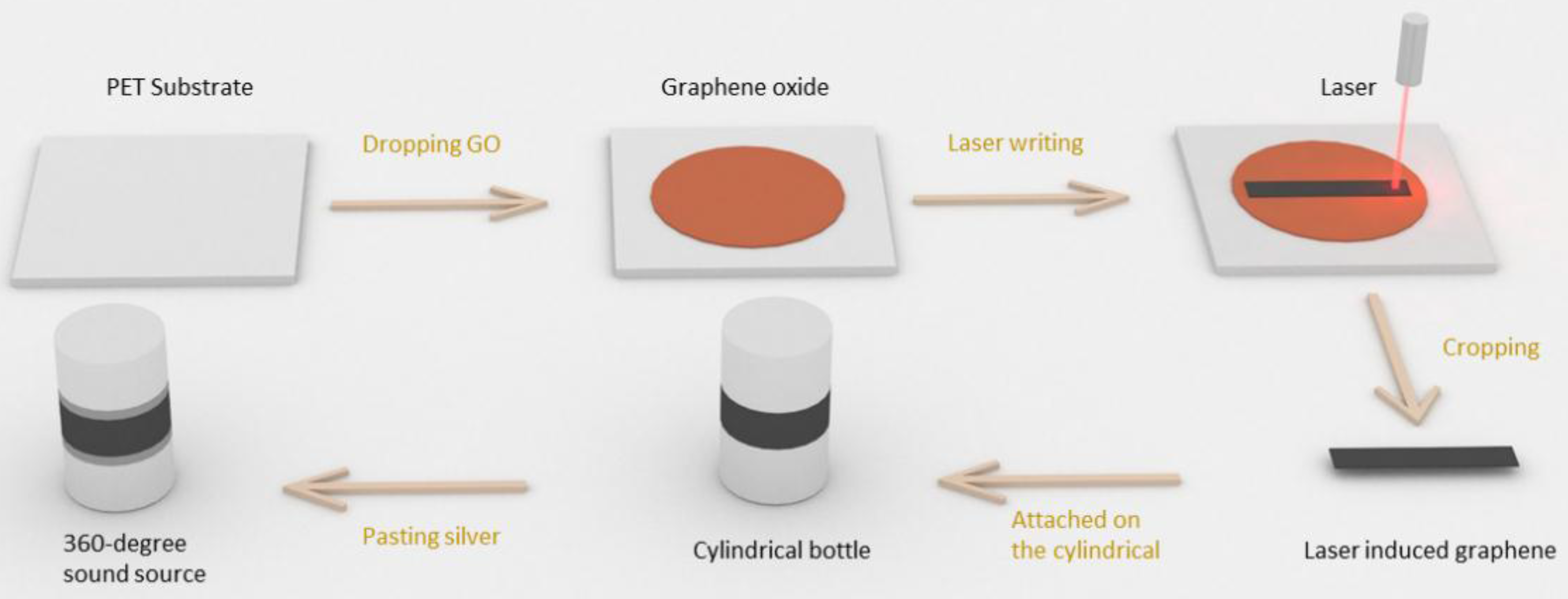

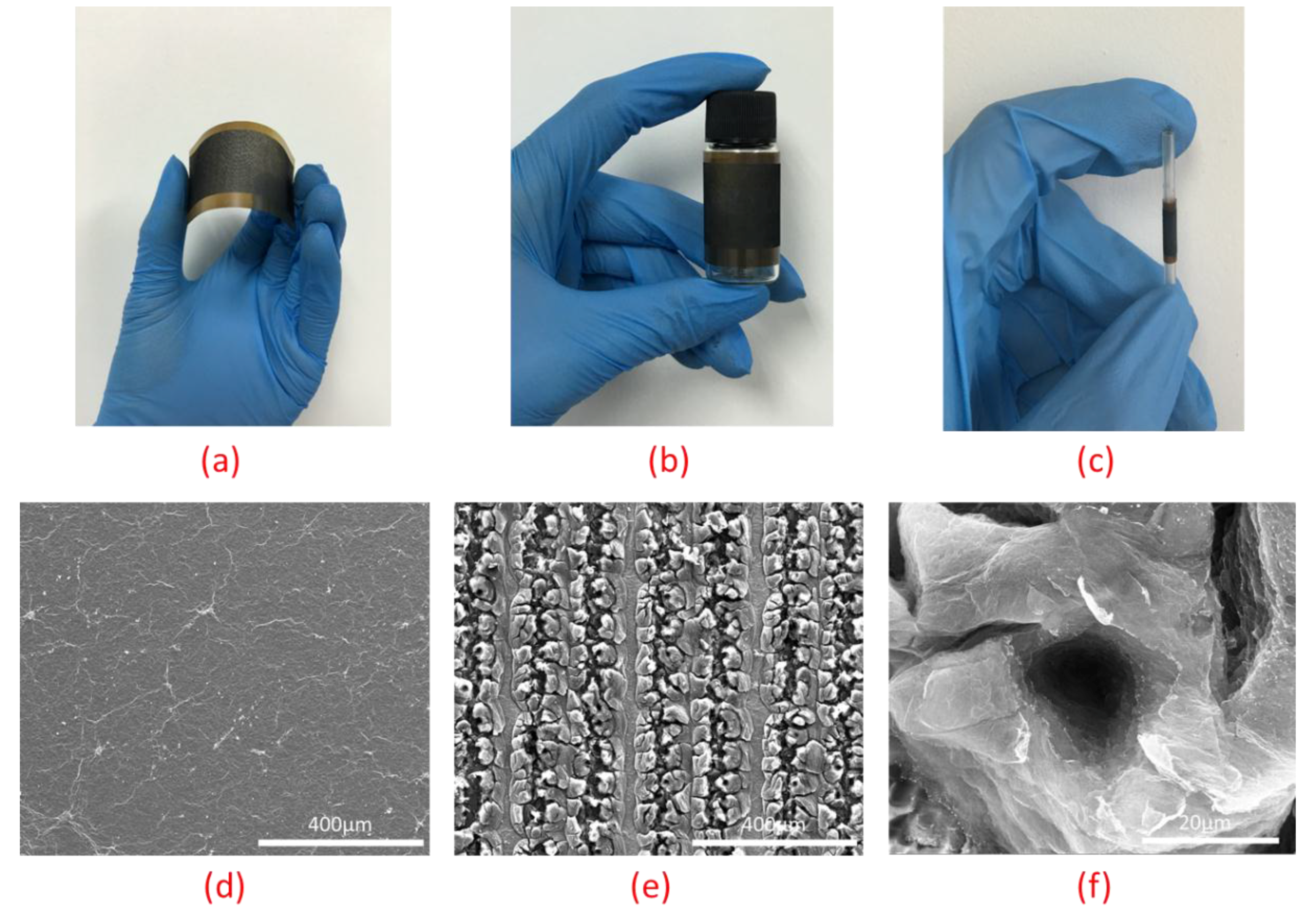
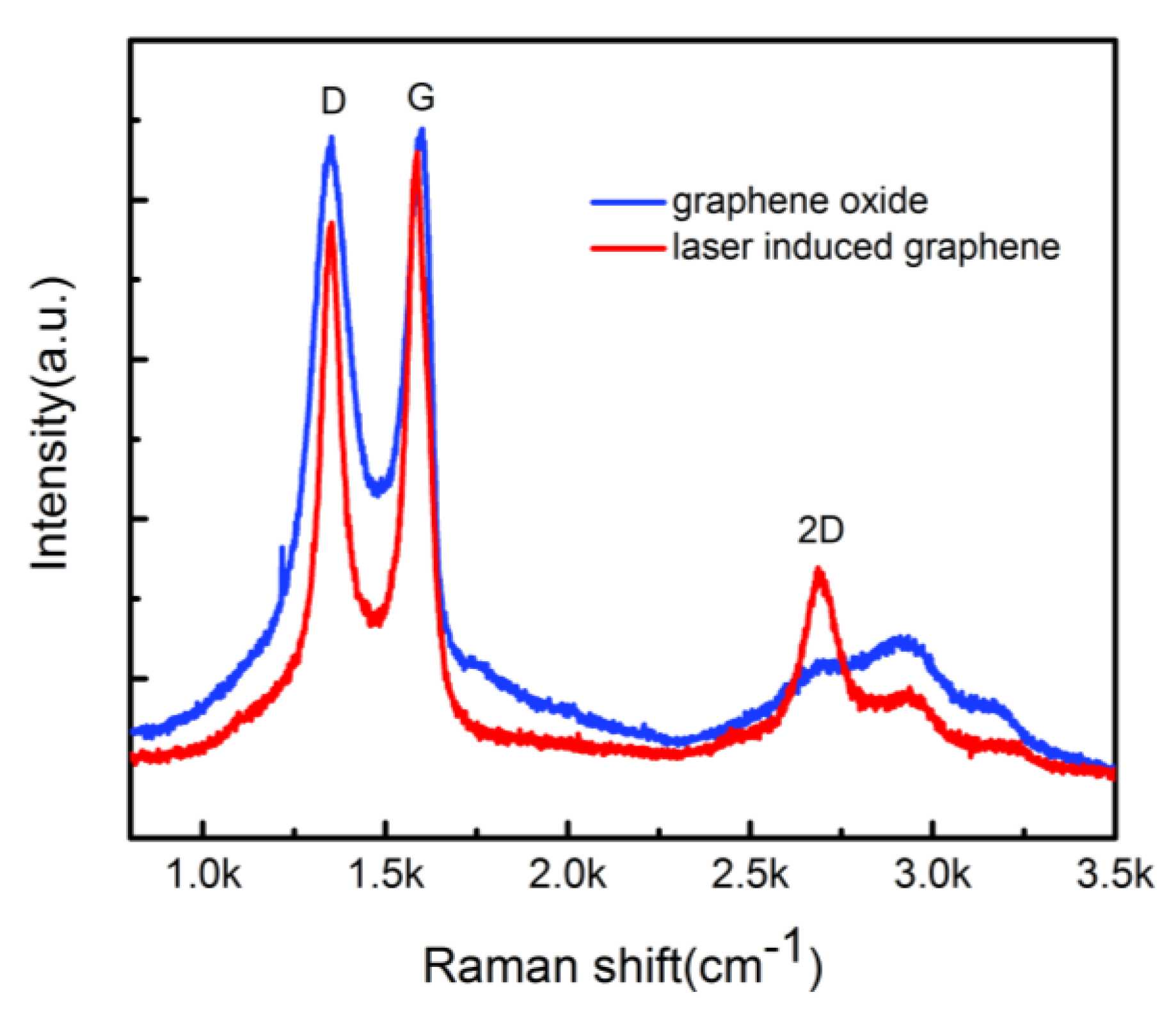
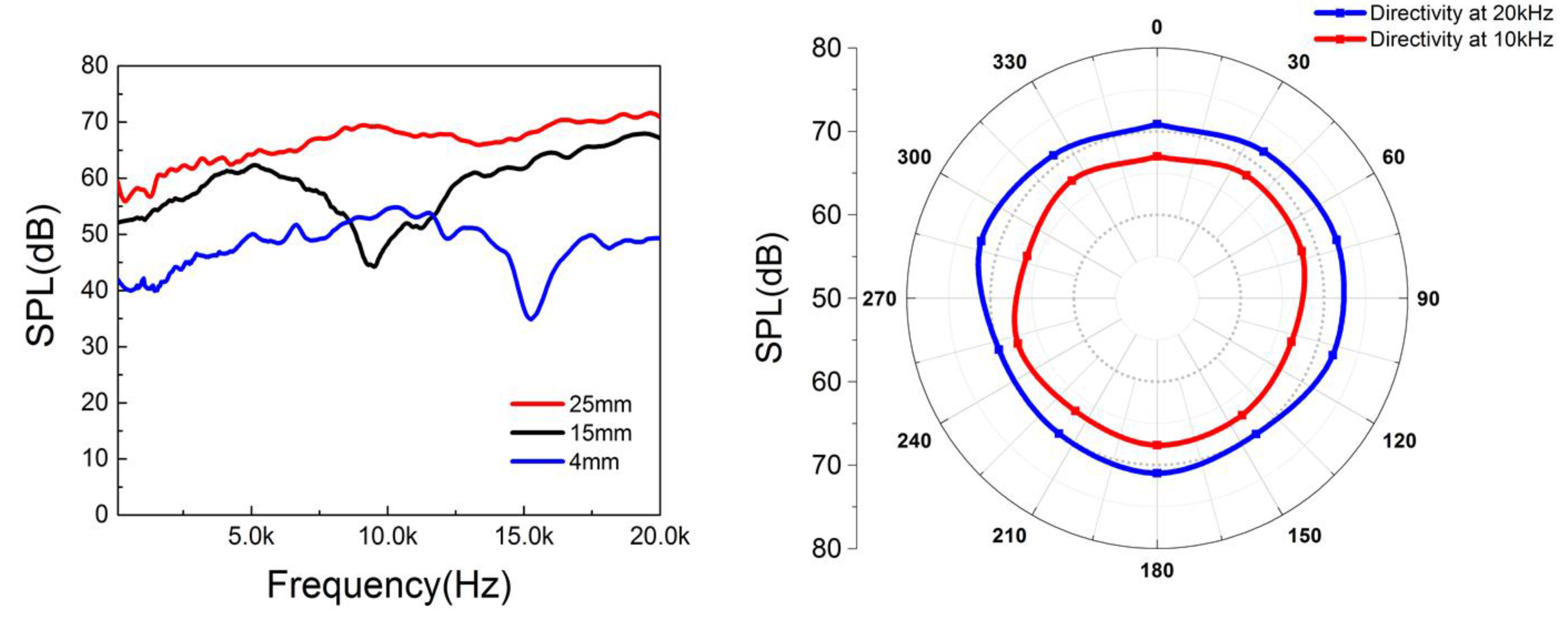
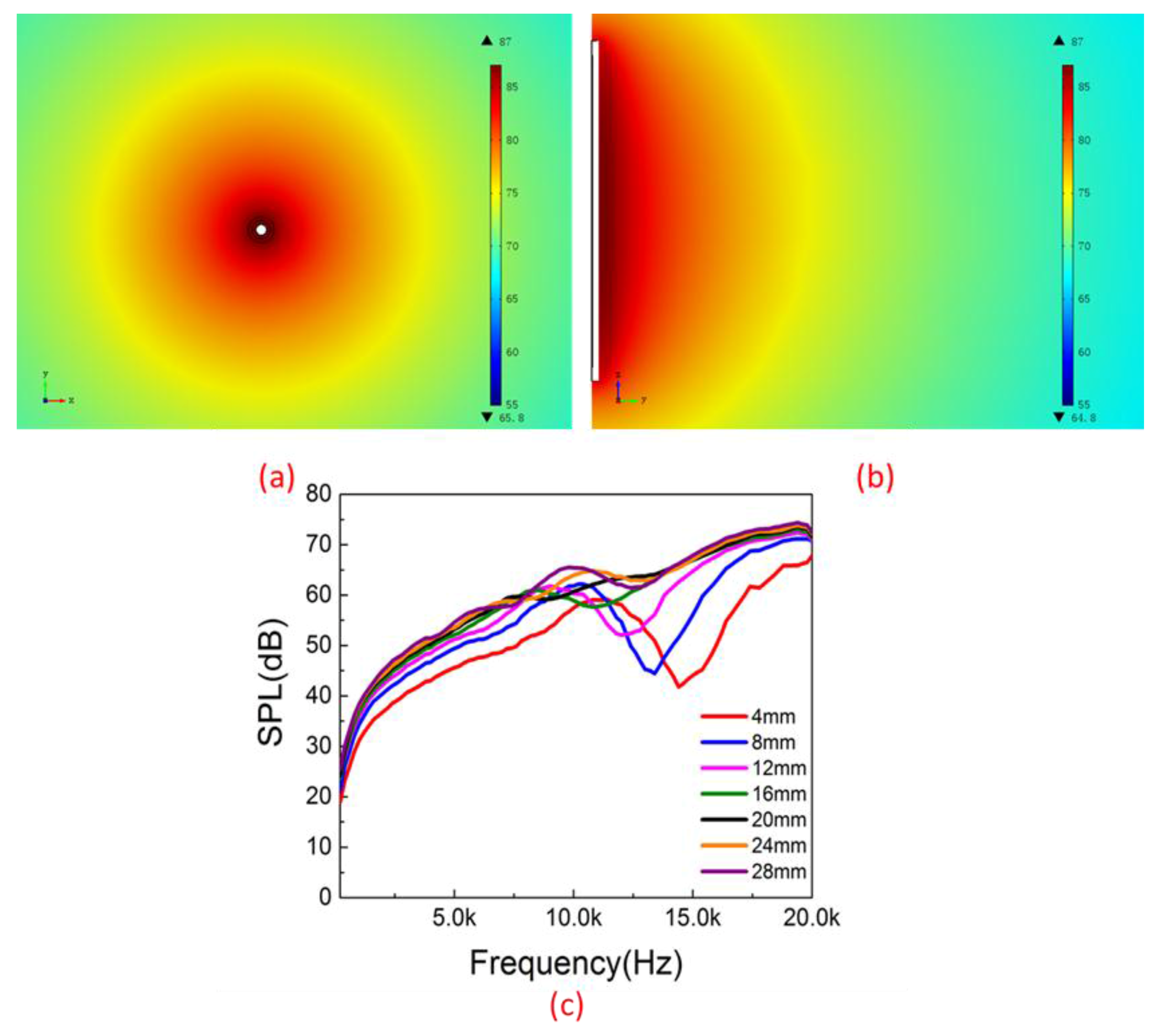
© 2016 by the authors; licensee MDPI, Basel, Switzerland. This article is an open access article distributed under the terms and conditions of the Creative Commons Attribution (CC-BY) license (http://creativecommons.org/licenses/by/4.0/).
Share and Cite
Tao, L.-Q.; Liu, Y.; Ju, Z.-Y.; Tian, H.; Xie, Q.-Y.; Yang, Y.; Ren, T.-L. A Flexible 360-Degree Thermal Sound Source Based on Laser Induced Graphene. Nanomaterials 2016, 6, 112. https://doi.org/10.3390/nano6060112
Tao L-Q, Liu Y, Ju Z-Y, Tian H, Xie Q-Y, Yang Y, Ren T-L. A Flexible 360-Degree Thermal Sound Source Based on Laser Induced Graphene. Nanomaterials. 2016; 6(6):112. https://doi.org/10.3390/nano6060112
Chicago/Turabian StyleTao, Lu-Qi, Ying Liu, Zhen-Yi Ju, He Tian, Qian-Yi Xie, Yi Yang, and Tian-Ling Ren. 2016. "A Flexible 360-Degree Thermal Sound Source Based on Laser Induced Graphene" Nanomaterials 6, no. 6: 112. https://doi.org/10.3390/nano6060112





